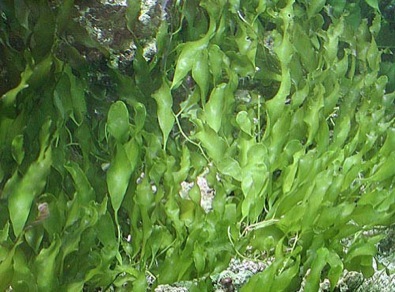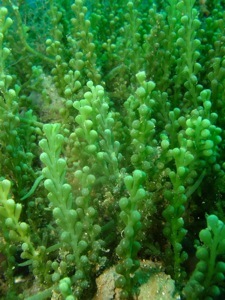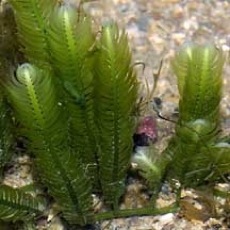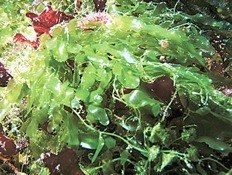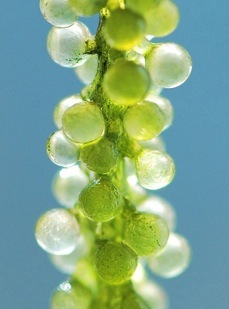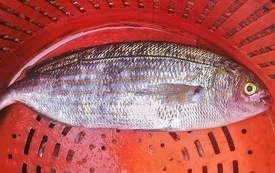Caulerpa: Warm-Water Salad and Pest
Caulerpa ssp.would seem to be a paradox. Eaten around the world by thousands for thousands of years but called a killer and toxic by modern man. How does one sort that out?
Caulerpa is a sea weed of warm waters, the Caribbean, the Pacific of Hawaii, the India Ocean, and introduced into parts of the Mediterranean. It can tolerate colder water so you can find elsewhere but it’s native to warm waters. Of late it has been found in the lower portion of Indian River Lagoon, a 156-mile long estuary on Florida’s east coast.
Caulerpa, said KAWL-er-puh, becomes a “killer” when taken out of its natural environment and put some place where there are few things around to eat or oppose it. Why would it get moved around? People emptying their salt water aquariums. Seems the Caulerpa is a nice nitrogen-absorbing plant for your living room aquaculture but folks dump their south sea hobby when they’re bored with it. The non-native Caulerpa takes root, literally, and drives out native sea weeds. Some native fish and crustaceans are not used to and to them it is toxic. And that is how the edible becomes a toxic killer of internet warnings. Well… almost. What about human toxicity
Caulerpa has fed many for millenniums. Two studies, in 1984 and 2000, say Caulerpa is not toxic to people, well.. at least not to lab rats who got fed Caulerpa. It may be that some people have an allergy to it. One case, however, did come under scientific scrutiny and Caulerpa just might have been at the wrong place at the wrong time.
A non-native kind of Caulerpa was released into the Mediterranean where a bream, the Saupe (Sarpa salpa) eats it. A 1993 report said an Israeli woman had symptoms of “ciguatera” poisoning but there was no ciguarera reported in the area. Ciguatera occurs chiefly in the Caribbean most often caused by eating barracuda, and depending upon what it ate. The Saupe she ate, however, had been eating non-native Caulerpa off the coast of Israel. So the Caulpera became suspect. One theory is the Saupe eats a lot of Caulerpa and builds up something that can cause poisoning or affect sensitive individuals. Another possibility is the Caulerpa in the fish was affected like barracudas and she had a case of ciguatera. No answer was found. However the story does not stop there.
As if that ambiguity was not enough the fish she ate, Sarpa salpa, is — and I know you aren’t ready for this — a recreational drug. If the fish eats the right — or wrong diet — parts of it, particularly the head, have a chemical similar to LSD. The effects include vivid hallucinations within minutes of eating it which can last for days. In 2006 two men, one 90, were hospitalized in France after eating Saupe. The older suffered auditory hallucinations a couple of hours after eating the fish followed by vivid nightmares for two nights. The forty-year-old had audio and visual hallucinations for the next day and a half. Apparently from Roman times through the Middle Ages the fish was caught precisely for the hallucinations it would produce.
The symptoms of the Israeli woman, those who get ciguatera, and occasional Caulerpa reports are similar. Those can include a mild numbness of the tongue, dizziness, coupled with a cold sensation in the feet and hands, difficulty in breathing and loss of balance. No deaths reported. So while thousands eat it every day there is occasionally a report about a response to it. The cause is rather fuzzy if even related.
Caulerpa has been consumed raw in salads, cooked and in desserts. The most commonly eaten species is C. racemosa, which has a pleasant, slightly peppery taste. It’s quite popular in Hawaii and in the Philippines. One draw back is that it deteriorates quickly
Regardless of species consumed of Caulerpa can lower blood pressure. It is also antifungal. Also commonly eaten are C. taxifolia, C. lentillefolia, C. cupressoides, C. peltata, C. serrulata, C. sertularioides, and C. brachypus. Presumed to be edible but I’ve found no reports of C. Floridana and C. Mexicana, respectively below. Caulerpa that resemble “grapes” racemosa, is the most common eaten. The Chinese like to fry it in pork fat, mince it, then eat it.
Green Deane’s “Itemized” Plant Profile
IDENTIFICATION: Caulerpa racemosa is a highly variable species. The typical racemosa, upper right, has short erect branches bearing crowded ramuli with short stalks and oval or spherical tips. The arrangement and shape of the branches differ among the numerous varieties. The branches (called ramuli on seaweed and coral) can be sparse or dense. They are arranged radially, alternately, pinnately or irregular on the erect branch. The tips of the branches can be shaped, like a top, a ball, or a disk. Plants growing on a sandy bottom in calm water tend to have dense branches with club-like ends. Those in rock, wave exposed areas tend to have ball like ends. They grow to about four inches high, found in the intertidal area and below, protected from strong wave action and or currents.
TIME OF YEAR: Year round
ENVIRONMENT: Warm waters where it is native, but can also be found in cooler waters introduced
METHOD OF PREPARATION: Raw in salads or steamed or boiled

